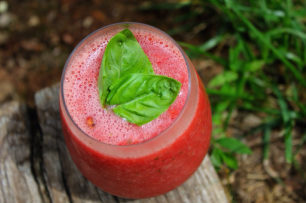
 We welcome signs of spring and yet winter is still reminding us that it's not over yet. This can be a challenging time of year. We are in transition between the cold of winter and the warmer days ahead and in this transition of seasons many people get sick. Taking our cues from nature, we can try to maintain a healthy balance. Think like a seed. Buried deep in the earth, it is still, quiet, and waiting. What does a seed need? Warmth, water, and nourishment, so that when the growing season arrives it can grow and flourish. Like the seed we need to stay warm: dress in layers, so you are not caught when the weather changes and the cold winds blow. Stay hydrated: drink plenty of water and warm teas. Get plenty of rest: restful sleep is important to the body because that is when the body processes toxins and rejuvenates itself. So, not a good time to burn the candle at both ends! And finally, eat nourishing foods. Honor your natural desire to eat warm cooked soups and stews when it is cold and change to lighter meals as the weather begins to warm up.
0 Comments
There is a certain stillness to winter. Snow muffles sound, the darkness of night is lingers, and even the most outdoor enthusiast spends more time indoors out of the cold. After the flourish of activity that surrounds the holidays, it is a good time to pause and think about what you need to feel your best this winter. Looking at the season from an Ayurvedic perspective, the qualities are cold, dry, windy or mobile and expansive. Our modern minds may be disconnected to the rules of nature, but our bodies are not. This is why we experience dryness of skin and nasal passages, chapped lips, achy joints, and tend to experience more coughs and colds. What will keep us in balance with nature and also balance our nature is to incorporate things with the opposite qualities into our everyday life. In all aspects of life, think warmth, moisture, smoothness and grounding. Here are some tips for feeling your best this winter.
Do you want to eat better, feel better, and minimize your chances of getting a fall cold or flu? Then take your cue from nature. In the fall, trees shed their leaves, animals gather food for the winter, and we begin to see an abundance of apples, pears, squash, carrots, beets, and many other root vegetables in our markets. Being aware of what nature has to offer leads us to eating what is actually most beneficial for our minds and bodies right now. Eating seasonally is the best way to nourish the body and guide us through the change of season with ease. In the fall we need to shore up our reserves, build strength, and support our immune system. Just like the leaves change, we need to change our diet and move away from the cold salads and raw foods of summer and favor warm, cooked vegetables, soups and stews. Apples and root vegetables are readily available this season and are grounding, warming and satisfying to both the mind and body. Here are a couple of recipes that highlight the fall harvest. Spiced Apple Sauce 1 cup apples 1/3 cup water 1t ghee ¼ t each: cinnamon, ginger and cardamom powder Cook apples in water until soft. Add ghee and spices. If you would like it sweeter, add 1 T raw sugar or maple syrup. Roasted Root Vegetables Preheat oven to 375 degrees 6 carrots cut in ½ inch rounds 1 rutabaga, peeled and cut into ½ inch cubes 1 turnip, peeled and cut into ½ inch cubes 1 medium onion, cut into chunks 2 garlic cloves, minced 3 T fresh rosemary, chopped 1 T fresh thyme, chopped ¼ cup olive oil In a large bowl, combine all vegetables and herbs. Toss with olive oil. Spread vegetables in a large shallow pan and roast, stirring occasionally, for one hour or until tender. Season with salt and pepper. A favorite family quote, is from our son, Evan, who when asked about his kindergarten day, replied: “I tried to be cool, but I wasn’t!” It’s hard to be cool. Especially in the summer! Ayurvedically speaking, as the external temperatures rise, our internal temperatures rise as well. We naturally seek ways to cool the body, like sipping a tall glass of lemonade or eating a cool slice of watermelon. But we also need to “cool” our minds. The fast pace of everyday life in the summer goes against the need to balance a body that is already “hot” and can surface physically as inflammation of the skin, or loose bowels, or emotionally as irritability, anger or criticism. Luckily, if we pause to take in what the season has to offer, we notice that summer naturally provides us with nourishing elements that cool both mind and body. To bring balance and harmony back to the mind and body, try these cooling tips: Eat cooling foods; Fresh vegetables and fruits and leafy greens Use spices such as coriander and fennel, and herbs like cilantro and mint Take time for mind cooling activities: Go for an early morning or early evening walk Take a dip in the cool lake Keep a daily meditation practice And when the summer heat is just too hot to handle, try this Ayurvedic version of Gatorade from Vasant Lad at the Ayurvedic Institute: Pinch of raw sugar Pinch of salt Juice of ½ lime 1 cup water Mix till sugar and salt are dissolved. Add lime juice and enjoy! Hydrates both mind and body As the melting of ice and snow give way to the new growth of spring, our bodies go through a similar cycle of change. The body naturally prepares for warmer weather by metabolizing winter fats--our own detox cycle. As the fats are moved from the body, our circulatory and respitory channels can become clogged. Symptoms often include runny nose, sneezing, headaches, puffiness of the skin, and a general feeling of heaviness or loss of appetite. These are signs that the body is building up congestion.
Spring is Kapha season. The characteristics of Kapha are heavy, cool, wet, stable and building. You can observe these characteristics in nature and the body tends to mimic nature. To help the body stay balanced and not accumulate excess kapha throughout this seasonal transition, we need to incorporate the opposite characteristics into our everyday living. Here are some spring tips that support our natural balance.
Have you ever thought of dry skin, and chapped lips as an imbalance in the body? Ayurveda sees the human body as an aspect of nature and thus is affected by nature. Early to mid-winter is Vata season, the weather is windy and irregular; the air gets cold and dry. The change in nature can show up in our bodies as dry hair and skin, chapped lips, sore throats, difficulty sleeping, or inability to focus. A basic principle of Ayurveda is that like increases like, and opposites balance. So, to balance the cold, rough, dry, irregular quality of nature we need to think…warm, moist, soft and regular. Healthy oils, inside and out can greatly reduce dry skin. Cooking with organic oils such as coconut oil, olive oil and ghee help lubricate the tissues from the inside out. As for the outside, applying warm coconut oil or sunflower oil regularly to the body moisturizes and nourishes the skin while also calming the nervous system. For a deeper experience try the wonderfully grounding and nourishing Ayurvedic practice of daily self-massage called, abhyanga. The practice of abhyanga detoxifies the body and stimulates the energetic channels. Place a small container of organic sesame or coconut oil in a bowl of hot water to warm it. Rub a dry brush over the skin. Begin by massaging the warmed oil into your scalp and face, then continue to gently massage the whole body. Let the oil absorb for a few minutes then shower with warm water. The water helps the oils absorb into the skin. It is a wonderful way to nurture yourself! One last tip… To remedy dry nose and throat, take a small amount of sesame oil in your palm, and with your pinkie finger apply the oil to the inside of each nostril. This can be done before you go to bed and again in the morning.
All oils should be organic, cold or expeller pressed, and can be found in the grocery section. If you wouldn’t eat it, don’t put it on your skin!  As I write this, a definite hint of fall is in the air. It is drier, windy, cool, irregular - as in warm one day cool the next- hey wait, that sounds very Vata! Indeed we are moving into fall, which is Vata season. As mindful yogis and students of Ayurveda, we recognize there is a change happening. And to keep ourselves in balance we need to change with the season. A couple of tips...more moisture, as in plenty of fluids, moist foods and healthy oils-both inside and out. This will help balance vata in the body and mind. Also, to combat that restless or scattered feeling, try to keep a regular schedule of eating, sleeping and exercising. More moisture and a regular schedule will help keep you balanced, grounded, and well hydrated, ready for fall! A couple of events coming up... . Fall Cleanse Workshop presented by Julie Welle Saturday October 25th 1-3pm Mind Body Solutions Yoga Studio, 17516 Minnetonka Blvd. Minnetonka, MN Think of it as a workshop for your digestion! Reset your metabolism, clean out any old habits, and hopefully begin to practice some new ones. Workshop includes a detailed plan, recipes, grocery list and supportive practices such as asana and pranayama. Ayurveda Day (presented by the Minnesota Ayurveda Association) Saturday, September 27th 11:00-5:00pm Lake Harriet Spiritual Community Building 4401 Upton Ave South Minneapolis, MN Mini classes on diet and lifestyle, Ayurvedic Yoga Classes, Ayurvedic Cooking, Products, food, practitioner booths and much more!  There may not be any year where we have celebrated the first day of summer as much as this one, welcoming the heat after our long, cold winter and cool spring! As the weather heats up, so does the body. Summer is the time when we begin to accumulate heat energy. Long days of warmth and activity build heat(pitta) in the body. As our body always seeks balance, it is our natural instinct to counter that heat with a glass of cold lemonade or an ice cream cone. But nature also provides some cooling foods that help move excess heat out of the body. An abundance of fresh fruits and vegetables can be found at farmers’ markets and local grocery stores. Most seasonal produce has a cooling effect on the body, but some of the best are cantaloupe, watermelon, berries, grapes and peaches, along with leafy greens, broccoli, snow peas and asparagus. To keep the body in balance, it is best to favor these fresh foods and avoid foods that are heavy, rich, or high in fat as they will actually build more heat in the body. Here’s a recipe for a very cooling beverage, courtesy of the Joyful Belly website: Watermelon Basil Smoothie Puree 1T. chopped basil and 2 cups watermelon in a blender. Blend and serve. The watermelon’s sweetness has a calming and cooling effect. The bitterness of the basil brings out the sweetness of the watermelon and also has diuretic properties purging excess fluid from the body. Coconut oil also has a cooling effect on the body both inside and out! You can take 1 teaspoon with a meal, cook with it, or rub it into the skin. Rubbing the soles of the feet with coconut oil before you go to bed is both a cooling and calming bedtime routine. Enjoy your summer and stay cool! Julie Welle |
Julie Welle| Hatha Yoga Instructor | Archives
December 2021
Categories |

 RSS Feed
RSS Feed
